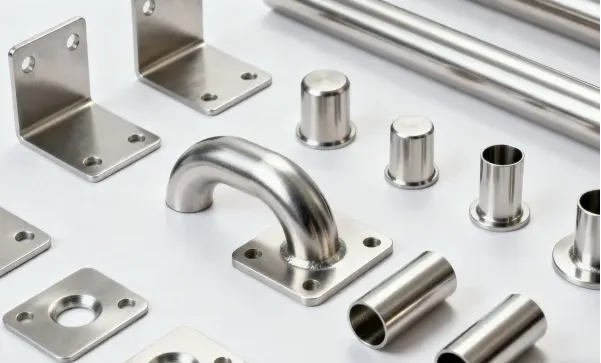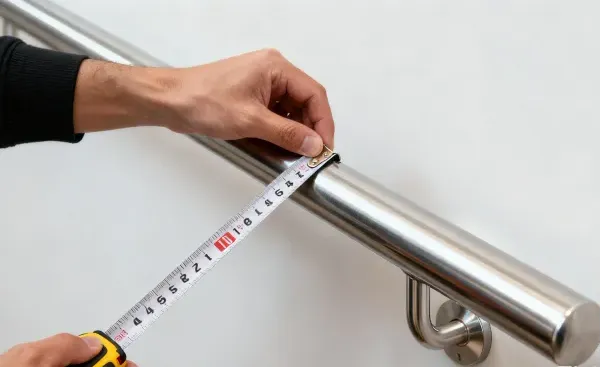Choosing the right handrail parts can be confusing. Pick wrong and you get wobble, rust, and callbacks. Here’s a simple path to choose durable, safe stainless steel handrail fittings that install fast and last.
Stainless steel handrail fittings are the precision handrail components—brackets, elbows, end caps, base flanges, and connectors—that link the rail to posts, walls, and glass. Built for durability and corrosion control, they make a structurally sound system for stairs, ramps, and balcony edges with clean installation and low upkeep.

raccordi per corrimano in acciaio inox
Handrail fittings turn straight tube or pipe into a continuous line that feels solid under the hand. Elbows bend your route around landings. End caps keep the look sleek and safe. Base flanges and wall mount plates attach the handrail to posts or concrete. Good parts are made from stainless steel and tested for integrity, so the system stays tight through wear and tear.
“Fittings are essential components in any handrail build. They provide stability and support where the rail meets structure.”
If you’re planning a full system, this overview pairs well with a deep dive into corrimano in tubo di acciaio inox so your fittings and tube specs match from day one.
Select fittings based on where they live. Indoors, 304 often works. Near pools or coastlines, 316 is better thanks to added molybdenum and stronger corrosion resistance (ASSDA e Outokumpu provide useful grade guidance). Pick a finish that matches your space: classic brush for maintenance-friendly surfaces or a higher polish for visual shine in a commercial lobby.
Table — Common Grades & Use Cases
| Grado | Typical Chromium/Nickel | Strengths | Limitations | Miglior utilizzo |
| 201 | Lower Ni, Mn added | Budget, formable | Less corrosion margin | Dry interiors |
| 304 | ~18/8 | Workhorse, widely available | Not for aggressive chlorides | Offices, malls |
| 316 | 2-3% Mo | Strong resistance to chlorides | Costo più elevato | Pools, seaside, food plants |
For exterior projects or balustrade designs, review examples like ringhiera per scale in acciaio inox to see grade and surface choices working together to enhance both safety and visual appeal.
A smooth install starts with the right parts:
Tip: When choosing railing fittings, match diameter (for example, 42.4 mm OD) so parts slide together correctly. This keeps the top rail line neat and aesthetically pleasing.
To see component pairings in context, scan the product shots in corrimano in acciaio inox per scale and double-check how each component seats and bolts up for a secure fit.
Many projects compare steel handrail fittings to aluminum parts. Aluminum is light and easy to machine; stainless is tougher and extremely durable. If you expect heavy crowds, cleaning chemicals, or outdoor spray, stainless steel railing parts usually deliver better long-term longevity with less surface change. The look also complements modern architectural lines.
When your design leans to open glass runs or a minimalist architectural styles concept, see how stainless ties into systems like ringhiere in acciaio inox per balconi—it’s a popular choice for high traffic and long service life.
A comfortable stair handrail needs a graspable profile. In many markets, a round handrail of 42.4–50.8 mm diameter fits most hands. For a square or rectangular rail, check grasp rules in your local building code (e.g., ICC IBC). Strong posts, tight connectors, and proper spans keep the rail system structurally efficient and functional.
You can confirm dimensions and layouts using the examples in stainless steel pipe railing before you finalize shop drawings.

Sizing the handrail and pipe
For a staircase, plan how the handrail meets walls, posts, or glass:
On glass runs, choose clamps sized to your panel thickness and environment. If salt spray is a concern, grade 316 hardware helps ensure long service life. Real-world photos in accessori per ringhiere in acciaio inox show clamp and post combinations that complement both residential and commercial spaces.
Surface finish changes the mood. A satin brush softens reflections and hides fingerprints. A higher polish pops under spotlights, adding appeal in showrooms. Powder-coated accents can enhance contrast with wood treads or concrete landings while keeping the handrail line stylish and standout.
If you prefer a cleaner edge detail, rounded end caps and contoured elbows feel visually calm while users move along the handrail. Explore detailing ideas and joint close-ups in ringhiera in acciaio inox personalizzata to refine your palette for indoor and outdoor spaces.
For multi-flight jobs, pre-label boxes by floor and stair direction. That simple step cuts install time by 10–20% on typical projects. For layouts, see staging ideas in Ringhiera in acciaio inox 316 photo galleries.
“Measure twice, drill once. Clean holes and use the right anchor—chemset for cracked concrete, sleeve anchors for solid block.”
Every handrail must ensure user safety and integrity. Typical points include consistent height, return ends, and smooth transitions. To stay functional, check local codes (IBC/EN standards) for grasp size and load testing. For aggressive washdowns, pick a high-quality stainless steel grade and seals that block water at the base.
Planning a mixed-material run with wood or stone? Cross-check compatibility with produttore di ringhiere in acciaio inox guidelines so your materials age together without staining or galvanic issues.

handrail systems
In a residential remodel, a sleek tube handrail with rounded end caps gives aesthetic appeal and functionality with minimal visual clutter. In arenas and transit hubs, heavier posts and continuous handrail runs are an excellent choice for crowd flow and cleaning ease. Stainless is versatile: it’s a standout in schools, clinics, and offices where fresh air and light matter.
Case in point: a three-story office retrofit swapped aging painted steel for satin 304. Maintenance tickets dropped, and the new handrail better complemented the modern glass and concrete. See similar outcomes in stainless steel handrail outdoor progetti.
If you’re planning a hybrid layout, browse balaustra in vetro per scale for transparent runs that still feel strong and calm.
What is the main difference between 304 and 316 for handrail fittings?
304 is the common workhorse; 316 adds molybdenum for better chloride corrosion resistance. Use 316 near pools or sea air for longer life. See ASSDA for grade background.
Can I mix finishes on the same handrail run?
Yes, but keep the handrail line consistent. Use satin finish on touch parts and higher polish on accents. Consistency across the top rail makes details feel seamless.
How do I choose between wall mounts and posts?
Use wall mount handrail brackets in tight halls or retrofits. Use posts for open lobbies or where walls aren’t load-bearing. Glass with glass clamps offers transparency in a modern architectural setting.
Are stainless fittings better than aluminum?
For heavy use and cleaning, stainless is more durable and holds its look. Aluminum is light and easy to machine, but stainless often wins for longevity and integrity.
Do I need special care after installation?
Rinse after construction dust, then mild soap. Avoid harsh chlorides unless you specified 316. This helps the system stay structurally sound and clean.
Will these fittings work with different staircase designs?
Yes—most handrail systems are modular to accommodate many staircase geometries. Use adjustable elbows and inline connectors to keep flow.
Need more real-world context? Compare layouts and details in balaustra in filo di acciaio inox e ringhiera in acciaio per scale to see how parts come together.
We’re a professional stainless steel manufacturer and exporter in China serving Industrial Distributors and Steel Wholesalers, Engineering Contractors and Fabricators, OEM/ODM Product Manufacturers, and Construction and Infrastructure Developers. We focus on consistent quality, clear drawings, and on-time delivery for B2B projects. If you’re an Importer / Trading Company / B2B Buying Office, our documentation and batch tracking make your work easier.
Le balaustre in vetro sono una buona idea? Il sistema di ringhiere in vetro più moderno per balconi e scale
Produttori di tubi in acciaio inossidabile: Tubi senza saldatura, in lega e in acciaio inossidabile spiegati
Tubi e tubazioni in acciaio inox saldati: 304 Stainless, 321, OD/spessore della parete e specifiche del tubo
Corrimano in acciaio inox: idee per corrimano e ringhiere in acciaio inox per le vostre scale